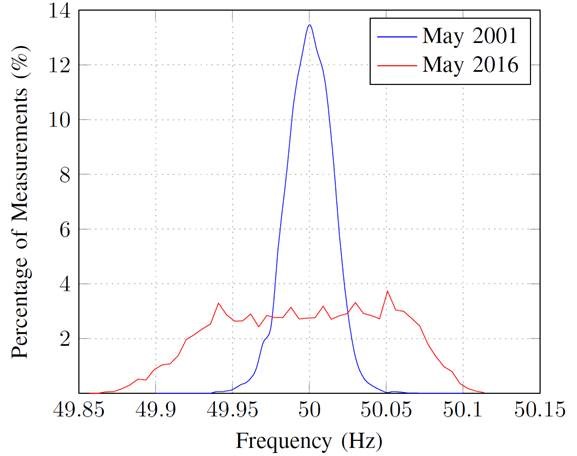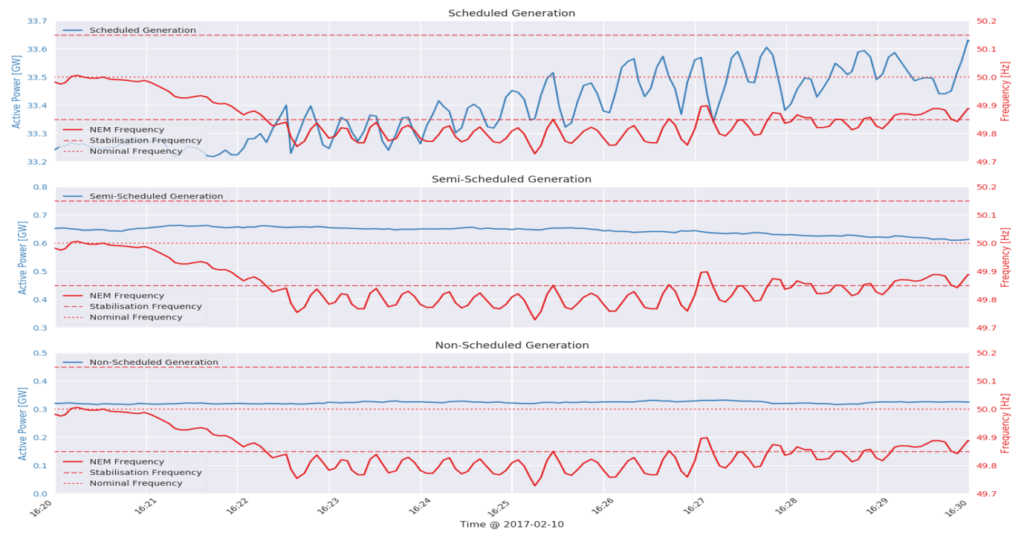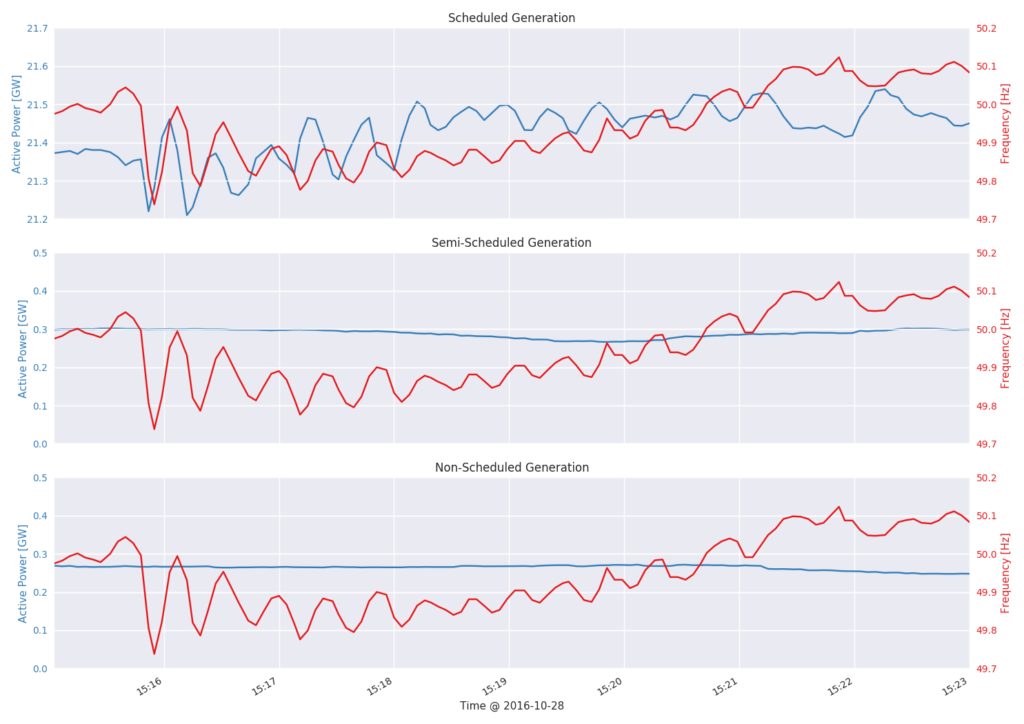In engineering, as in life, we all have moments when something that is troubling us suddenly crystallizes, the fog lifts to reveal an insight. So it was after several months of grappling with issues in the Frequency Control Ancillary Services (FCAS) market when I started to examine events in detail and study the performance of the power system.
On 1 Nov 2015, South Australia separated due to a communication protection error during a prior line outage, and the frequency control in the 35 minute islanded period was extremely poor. It was unlike any past separation event; it triggered under frequency load shedding for the loss of 150 MW of import. After a brief recovery to 50 Hz, the frequency meandered between 49.85 and 50.6 Hz before finally getting close enough to resynchronise 35 minutes later.
What intrigued me was the question,” How did the frequency control get to be so bad?”. I recalled a discussion with an industry colleague, a control technician from a thermal power station. He had said something questioning the control requirements in the FCAS specification and how it could be interpreted in two different ways. He disagreed with what was being required, as in his opinion “it would not control frequency”. As with most things electrical, measurements reveal everything, so we started looking into our PQ measurements. We could see extended periods where the frequency was just not constant (at least not at 50 Hz!).
I am fast arriving at the conclusion that the FCAS market has caused a significant number of unintended consequences which I am sure the designers of the FCAS market either did not contemplate or dismissed as unlikely to occur. Technological advances in control capability, the interconnectivity of control systems and the ability to alter the control mode of a generating unit in real time, these were unlikely to have been considered an issue in 1999. They are real now. The ability to switch and disable governors, or become frequency insensitive (turbine follow mode) between one dispatch interval to another is real now. The advent of switching controllers allows for “frequency services” to be dissected between frequency bands, and the service provided looks exactly like the market offer. So the design of a frequency service which started in a spreadsheet to identify the energy increase from governor action that the market would pay for, has now been reverse engineered into the controls. The services in the market, their structure, size and shape are exactly followed by the controls. The power system consequences of this type of control were not examined, as it was not thought it would be applied to the governors.
Prior to the NEM, all units had mandatory governor performance, tight deadbands and droop control. Each state operated its own area of control with AGC and interconnector flows controlled through tie-line bias. In a long skinny power system with weak interconnection, this is important. On introduction of the NEM, it was decided that the eastern seaboard could be controlled using one area of control, and the interconnector flow between states would be adequately controlled through the 5 minute market dispatch. So at the time the FCAS market was introduced, generators had mandatory governor control and the market was treated as an “enablement market”, meaning if you were enabled you were paid, but everyone provided the control.
For many years the FCAS market has worked, because control systems are not upgraded all at once. After about thirteen years of the FCAS market, control upgrades appear to have taken place in accordance with the market design. Once the upgrades became prevalent, the frequency control deterioration is evident. But here’s the problem; it is still meeting the Frequency Operating Standards (FOS). At the time the market was introduced, the Reliability Panel widened the FOS and added a percentage of time measure.
So now the market is asking, “What’s the problem?”
There are individuals, both regulatory and market, thinking that the oscillatory behaviour on the 10th Feb was caused by the loads! (Doesn’t Generation + Interconnection MW = Load? So it can be concluded that the frequency disturbance is caused by the load!) There is now a serious debate in the market over whether there is a problem if the frequency moves around within the normal operating band of 300 mHz. Figures 2 and 3 are derived from the 4 second data used to calculate “causer pays” factors in the FCAS Market.
As a system control engineer, I contemplate the loss of being able to study, predict and trust the response of the system when frequency controls are enabled and disabled on units across the country every 5 minutes. I can think of several engineers who are turning over in their grave. For light relief, I refer you to the sketch from Clarke and Dawe on the Energy Market: https://www.youtube.com/watch?v=ELaBzj7cn14 .
Seriously, the loss of primary control on the synchronous fleet is significant and there is talk of fast frequency services being provided by batteries, wind farms or demand side response!. Recent rule changes require network owners to ensure sufficient “inertia” and “system strength” be retained. So politicians are arguing that renewables are the cause of the loss of “system stability”. I know that on the highway of electricity, we are asking the Mini Coopers to correct for the loss of control on the Mac trucks. I say this because the control action on the large synchronous units is like having a driver that can’t reach the pedals and who only tries to steer once every five minutes. Given the length of the grid and the weak interconnections, perhaps it is time to start asking every generator to simply do their fair share of control and get back to a control philosophy that makes sense.
Kate Summers
Pacific Hydro
(with thanks to Ryan Jennings for the production of the charts.)




Thanks Kate, for this very interesting, well researched and provoking article. The Clarke and Dawe video almost looses the grib to be funny! The consequences that really hurt bring us back to rethink strategies. Your investigation shows so nicely that if market does not follow technology, it’s consequences can be fatal without anybody doing anything wrong (illegal). This should be enough proof to be more suspicious against failures, issues and interpretation possibilities of different parties when setting up rules and policies. A monetary comparison of savings over some years with one fatal error like a blackout can bring things into a very different perspective. That should not be forgotten! Also, grid operation is certainly also not the only area, where this is so.
Thanks Corrina,
As we grapple with frequency services delivered through a philosophy based in markets and competition, it has become evident that this is not suitable for the provision of a control function that was once mandatory for all generators. I am starting to think that we need to move away from competitive market thinking which by default aims to minimize the provision of the control action and instead look to implement a performance based criteria (and incentive) that encourages all generators to contribute to frequency control (as they once used to!).
Thank you for the interesting article!
I’m especially interested in figures 2 and 3 as I am looking for frequency measurement data (just the Hertz values) for the NEM.
Are the frequency measurements from AEMO publicly available? I could not find them.
Thanks,
Jo